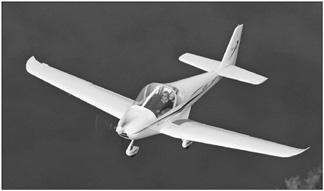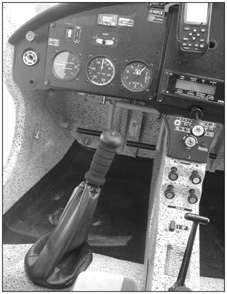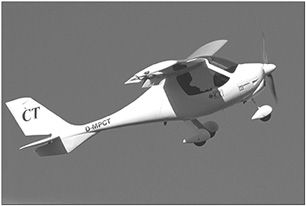
by Russ Niles
With a useful load of 700 pounds and range of more than 1000 miles, not to mention a respectable cruise speed of 124 MPH and options that include a panel-mounted GPS and future plans for a glass panel, its hard for anyone to say that the Flight Designs CT isn’t a real airplane. After all, there are plenty of used two-seaters on the market that don’t even come close in performance and features.
And not many of those have a 49-inch wide cabin (the new Cessna 172s cabin is 39 1/2 inches) or 90 percent composite construction or the option of an emergency parachute. In fact, at a well-equipped price of about $85,000, wed wager the CT would give any small single out there a run for its money.
But it doesnt have to. The CT and almost 20 equally spiffy cohorts have a new market virtually to themselves, at least for now. The CT is one of the vanguards of the Light Sport Aircraft category that was nominally created by the FAA last July and, for practical purposes, is becoming generally available this year.
The CT is modern, slick and quick and its also imported. Although it arrives in the U.S. from Germany, its a Ukrainian design, one of the growing number of aircraft that have sprouted from the former Soviet satellites and given new purpose for the military engineers and designers that found themselves out of work when the USSR collapsed.
A European Game
While we might pride ourselves in winning the Cold War, our aircraft industry isn’t even on the same battlefield when it comes to supplying the relatively high-end, ready-to-fly market that weve all been told will blossom under LSA. Frankly, there’s no made-in-the-U.S.A. equivalent to the CT or about a dozen others like it.
In fact, some of the very few U.S. aircraft that will take on the impressive first wave of Europeans-not to mention Australians and South Americans-in this potentially lucrative market are from another era, with noisy pusher configurations and basic accommodations. Two of Americas offerings (of nine) are biplanes originally designed in the 1920s.
Whats perhaps more telling is that Tom Peghiny, the owner of Flightstar Sportplanes and the importer of the CT2K, has several models of his own, home-grown two-place kit airplanes aircraft that would qualify for the new category as ready-built aircraft. But Peghiny, who, until recently, headed up an industry committee that established standards for the design, production and ongoing care of U.S.-built light sport aircraft, told Aviation Consumer hes not sure hell put his own designs into the mix.
It would depend, he said, on how similar aircraft types do in the new market. For now, hes content to take orders for the imported CTs (12 so far) and, like at least 10 other U.S. companies, forego all the development costs, money, time and paperwork necessary to launch a new aircraft and get into the market. Ive bet my whole career on it, said Peghiny.
Old News in Europe
The Europeans and others have already been through the wrenching process of birthing a new category of airplane; similar standards to LSA have been in place in many countries for up to 15 years. They view the U.S. market as a ripe plum for the fruits of their labors. U.S. companies are, at best, nervous about diving in.
I have been kind of on the fence about it, said Randy Schlitter, whose RANS Aircraft has been making relatively sophisticated kit aircraft for 23 years. It wasnt until late January that he made up his mind to put one of his dozen or so designs, the S7C Courier, a Piper Cub-like airplane, into the new market for $69,000, three times the cost of a kit. I feel like it should be $120,000, he sighed.
With the ready-built airplane, Schlitter and his company enter a realm of accountability and responsibility that might we’ll be beyond the capabilities of the grass-roots enterprises that have existed in the relatively unregulated world of amateur-built and ultralight aircraft. Materials and parts traceability are required as are notification protocols. Schlitter said he cant see much difference between the LSA requirements and those for certified aircraft. He should know. The Courier is also FAA-certified in the Primary category, a seven-year exercise that fizzled expensively.
The Sport Pilot/Light Sport rule has three basic goals. One is to provide a regulatory environment in which a domestic ready-built recreational aircraft industry could be founded. Its also designed to make flying more affordable and accessible to more people by easing instruction requirements and medical standards.
Finally, it sets standards for aircraft, flight instruction and maintenance where there were none because the existing regs simply couldnt be bent enough to accommodate the various means by which people have volunteered to get themselves airborne in the past four decades. In addition to fixed wing airplanes, the rule covers weight-shift aircraft, powered parachutes, gliders, lighter-than-air and gyrocopters.
Dan Johnson, the PR consultant hired by EAA to champion the new aircraft class, said it will probably take several years for Light Sport/Sport Pilot to integrate into the aviation industry but the benefits should be far reaching. Not only will existing pilots have another, less onerous option to get their flying fix, its anticipated that others who may have dreamed of flying but thought it too expensive or complicated will give it a try.
Maybe some of those boat buyers or snowmobile buyers will want to give this a shot, he said.
Future Boom?
Although accessibility and the need for regulation have guided the decade-long process of implementing the rule, the new categorys anticipated ability to give a suffering sector of the economy a much-needed shot in the arm has always been dangled as a carrot in front of those skeptical or outright hostile to the idea.

But since the weight-shift, powered parachute, balloon, gyrocopter and other hair-in-the-breeze methods of aerial locomotion were already relatively cheap and accessible (and weve never seen government regulation make anything less expensive) that really leaves the little airplane market as the logical target for this supposed economic boom.
U.S. manufacturers are clearly sitting on the fence waiting to see if there are customers to make the theory reality. Currently, their products, geared for homebuilders that must be assumed to have little or no experience building airplanes, for the most part look unsophisticated next to the ready-built airplanes poised to enter the domestic market from Europe, Australia and even India, Colombia and Brazil. In our view, if U.S. companies are to compete with the offshore products, there needs to be some hefty investment in research and development to make it happen-at a time when many manufacturers are already on the ropes.
I think you’ll see some consolidation happening, said Sebastien Heintz, whose family runs Zenith Aircraft. Zenith, through its European branches, has been building (or having built) finished aircraft for years and Heintz believes there are too many small players.
He said there are already rumors buzzing through the sector about mergers and partnerships in the works and he wouldnt be surprised to see the industry boil down to fewer than 10 major players.
In the meantime, even U.S. manufacturers admit theyre behind the power curve and have some serious catching up to do. The market is not going to be dominated by U.S. designs, said RANSs Schlitter. He also said that if the LSA standards are strictly followed, he doubts American aircraft will ever be price-competitive with imports. Our airplanes will be higher in price. They have to be, he said. Schlitter says many of the imports benefit from much cheaper labor costs and hes skeptical that the rigorous parts tracking, quality control and notification requirements embodied in the U.S. standards are applied in all the overseas operations.
Imports are allowed from any country with which the U.S. has a bilateral agreement covering production standards but Schlitter said that once those documents are signed, hes doubtful that anyone from the U.S. will check to see if they are upheld. They say they will but they wont, he said.
Heintz said he already has concerns about imported airplanes because most of them were designed around a maximum weight of 1200 pounds or less to meet standards in their own countries. The U.S. rule allows a maximum weight of 1320 pounds-1430 pounds for floatplanes-and he says he knows that some manufacturers are just changing the weights in their brochures without testing to see if their airframes can endure additional loading. All of a sudden, theyre adding 20 percent to the gross weight, he said. In my opinion, theyre just waiting for a disaster to happen.
Market Scan
Were going to go out on a limb here and assume that if youre reading this publication, youre already a pilot or at least involved in aviation. Maybe your medical is shaky or maybe youre tired of the expense of keeping a certified airplane when most of your flying is already day VFR, low and slow and mostly for fun.
Our survey of the airplanes that might be available when the rule is actually implemented-at this writing in late January that hadnt happened yet-shows that good things can come in small packages. But youd better be honest with yourself about how you’ll be using the new airplane before you buy.
First, if you think it will ever be used for instruction or rental, it must be designated as an SLSA aircraft. The S signifies that the plane was fully finished by the manufacturer and was ready to fly as soon as you signed the check. It also puts some heavy liability and insurance burdens on the manufacturer, which will boost the cost by thousands of dollars over what looks like a loophole in the regs but was actually an intentional escape from those costs.
If youre sure the airplane will never be used for commercial purposes (remember the resale value) you can buy an ELSA-designated aircraft. The E stands for experimental but its not the same as the other class of kit airplanes, which require the builder to do at least 51 percent of the construction. Under ELSA, the manufacturer can build 99 percent of the airplane and the builder might only apply placards or exterior trim.However, that minor contribution eliminates many of the insurance and liability concerns. Any manufacturer offering fully built airplanes will almost certainly offer the E option.
As we mentioned before, if its a state-of-the-art modern design youre after, you will likely be buying an import. But after that decision is out of the way, there are, as always, pros and cons to the various types and models in terms of capability and performance.

In our opinion, the most critical number is useful load, which we define as people, baggage and fuel. The 1320-pound weight cap imposed by the regs is partly designed to ensure you don’t use the airplane for much more than fun.
But with modern materials and clever design, some manufacturers have squeezed more than 700 pounds of lifting power out of their little airframes and thats more than enough for a weekend in the Hamptons for two. Of course, airplane manufacturers also seem to charge by the pound so you’ll find those choices at the higher end of the price scale.
If you fly alone most of the time but wouldnt mind taking a friend along occasionally, there’s a broad middle ground that will fit that compromise nicely.
Many of the new airplanes are happy on grass or pavement and most will tick along happily at more than 100 knots, burning less than 5 gallons an hour.
However, to paraphrase Henry Ford: you can have any kind of engine you want as long as its a Rotax. All of the imports and most domestic models have either a Rotax 912 (80 horsepower) or 912S (100 horsepower) buzzing up front or behind. Avionics appear to be up to you and it seems that non-certified gear is allowed.
If youre among the mechanically inclined, you can take a repairmans course and do most of the work on your airplane yourself. You can also buy one of the dozens of homebuilts (finished or not) that fit the regs.
But if fun flying is what its all about and the conservative side of you likes the idea of maintenance by an A &P, Lycoming or Continental under the cowl and a long, proven history, there’s another option. Dozens of standard category aircraft meet the weight and performance standards for LSA and are therefore legal for flight by someone with a Sport Pilot ticket. Most Aeroncas, some Ercoupes, some Cubs and many Taylorcraft are eligible and theyre a fraction the cost of most of the new stuff. Further, there’s wide market choice in older ragwings that qualify for LSA. Clearly, this is a market that wont lack choice.
Also With This Article
“Checklist”
“Light Sport Aircraft/Domestic U.S.”
“Light Sport Aircraft/Imports”
“The Grandfather List”
Contacts
Ace Aircraft, www.aceaircraft.net, 706-886-6341
IndUS Aviation, www.indusav.com, 877-464-6387
Quicksilver Manufacturing, www.quicksilveraircraft.com, 951-506-0061
RANS, www.rans.com, 785-625-6346
U.S. Light Aircraft, www.flyhornet.com, 760-518-0838
Zenith Aircraft, www.zenithair.com, 573-581-9000
ATEC Aviation, www.atecaviation.com, 604-581-0041
AveoTech International, www.aveousa.com, 210-568-3795
D Bar D Aviation, www.bbardaviation.com, 336-449-7770
Flightstar Sportplanes, www.fly-filghtstar.com, 860-875-8185
Hansen Aero, www.hansenaero.com, 770-427-6311
Interplane, www.interplaneaircraft.com, 313-468-2300
Kappa 77 USA, www.kappa77usa.com, 570-977-1125
Pipistrel USA, www.mcp.com.au/pipistrel-usa, 61-418-168-665
Rollison Light Sport Aircraft, www.rlsair.com, 812-384-4972
Sport Air USA, www.sportairusa.com, 501-228-7777
Sport Aircraft International, www.sportaircraftinternational.com, 830-896-8910
-Russ Niles is a freelance editor and writer. He flies a Cessna 140 and lives in British Columbia.





